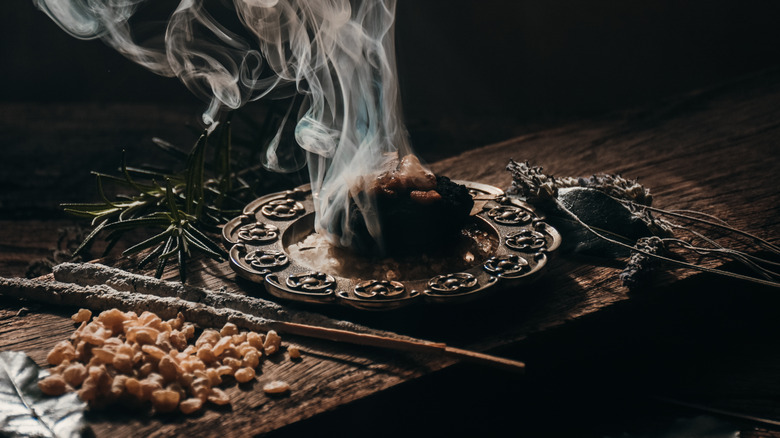Your Guide To Avoiding Cultural Appropriation In Your Wellness Practices
If you've scrolled Instagram or TikTok at any point over the past several years, you've likely come across wellness influencers who tout practices like using sage and sell high-priced spiritual healing retreats that may or may not facilitate the use of ayahuasca. Even discount stores like Five Below now sell mass-produced smoke cleansing kits featuring white sage or palo santo. What is sorely missing in the online wellness community is awareness of the fact that these are sacred rituals and ceremonial practices with deep ancestral ties to indigenous cultures.
Saging is actually the ancient native ritual of smudging, or the burning of medicinal plants to protect and cleanse the energy of a space or person. Traditionally, a large shell or clay bowl is used to hold the burning plants and the sacred smoke is fanned with a feather. While the plants represent the element of earth, the vessel represents water. The flame that lights the plants is a representation of fire and the fanning feather provides the element of air (via Legends of America). Smudging and other indigenous spiritual practices are meant to be performed privately and never for profit.
If you've taken part in paying for, recording, or profiting from indigenous practices without realizing the significance, you don't need to beat yourself up or feel like a bad person. However, once you know better, you are responsible for doing better. Here's how to ensure that your wellness practices don't include appropriating indigenous cultures.
Avoid exchanging money for spirituality
Indigenous healers do not accept money for their ceremonies and typically won't participate in retreats or other events that exist for profit. Unfortunately, this leaves an opening for non-native people to cash in on indigenous wellness practices. In order to package these practices in a way that seems genuine to unsuspecting audiences, they must be twisted to fit a more commercial narrative. As a result, inaccurate depictions and stereotypes of indigenous people and cultures emerge and persist. There is no way to promote and sell rituals that center around freely exchanging ceremonial energy without warping them.
All across the United States and Canada, native people have been persecuted for practicing their cultures' spiritual wellness customs for centuries. For non-natives to step in with cultural immunity and use them in unintended ways for the purpose of financial gain is simply exploitative. If you are considering working with someone who calls themselves a guide or healer or attending a spiritual wellness retreat, stop and consider whether paying for these services would be supporting the exploitation of indigenous culture by a non-native. There are other ways to achieve wellness.
Develop your own wellness rituals
There is nothing inherently wrong with a non-native person conducting their own private wellness rituals using smudging or other native practices. While you should avoid purchasing white sage due to concerns about overharvesting, there are plenty of other plants to choose from for smoke cleansing (via Plant Savers). Ideally, you would grow your own. Using these practices becomes appropriative when you make them a spectacle by publicly sharing photos or videos, especially in a promotional fashion or when you consume this type of content. True spiritual wellness isn't about social gain. It is about a personal connection between your mind, your body, and the universe, a god (or gods), nature, your ancestors, or your own energy.
If you feel a deep appreciation for indigenous culture, there are ways to respectfully learn and participate. Rather than being the recipient of a whitewashed online version of native practices twisted for the purpose of appealing to the masses for financial gain, go local. Research the native history of the land you live on online or through your local historical society. Visit local museums with native exhibits. Offer financial support to native communities by donating to organizations like the Native American Heritage Association or the National Indian Child Welfare Association. Read books and follow social media accounts by indigenous leaders. Most importantly, truly listen when indigenous people speak about their culture and experiences and amplify their voices by sharing their content—without adding your own opinion— whenever possible.


